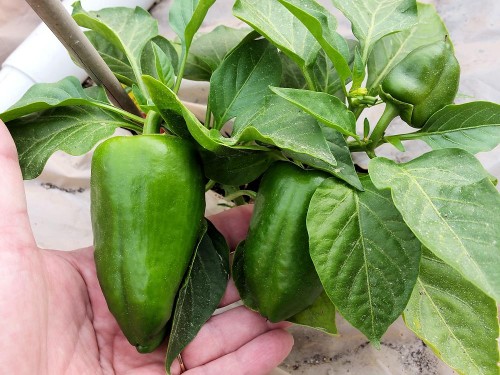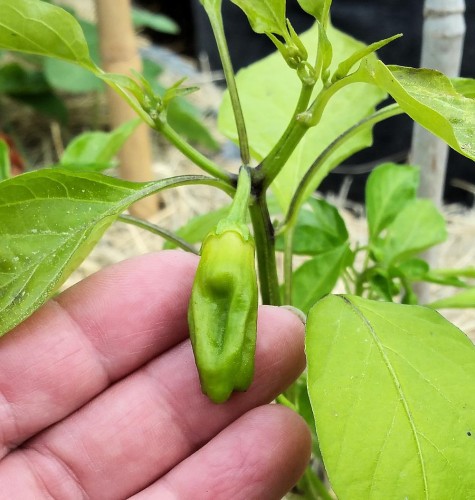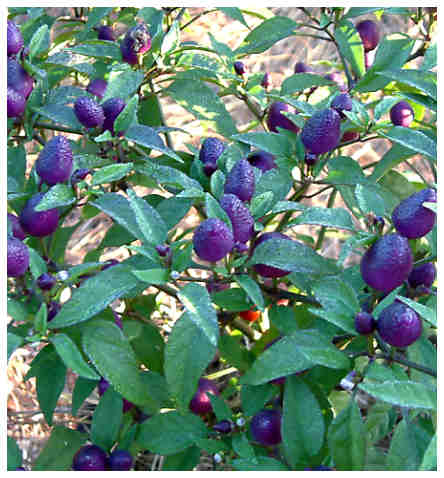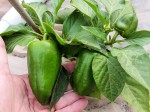Spring 2016 Garden — What’s Growing?
I think I’ve got my lineup set for this year, pepper-wise. I am probably growing far more than I should, and will be overloaded with fruit, but I have neighbors who wouldn’t mind a few peppers from time to time. So what’s in store for 2016?
Fear the Reaper
I have a post where I describe my showdown with the Ghost, Scorpion and Reaper peppers. This is a showdown that will last all year, so subscribe for email updates to keep up with what’s going on with them. But, I don’t just have them growing — let’s take a look at what else is in the garden.
Already Planted

Red Bell Pepper — It Already Has 3 Peppers!
I have the following already planted out in the garden:
- Red Bell: As the name suggests, a red bell pepper — no special variety. It’s a nice compact plant that already has rather large peppers on it! I’ll actually have to pick the largest this week or next, to give the plant a chance to grow some more.
- Orange Bell: I have two of these plants, which are tall and lanky. They both have peppers on them, but I may have to give one of them a pruning, just to compare a pruned plant against an un-pruned. Seems like an interesting comparison.
- Big Bertha: Another bell pepper, and this one supposedly has huge fruit. It will be interesting to see how the fruit compares to the other bells I have growing.
- Shishito: Somewhere between a mild (no heat) and a hot. I hear that most of the fruits have no heat to them, but then every once in awhile, one of the peppers has some kick to it. It also has a pepper already — doesn’t look anything like the bells — it’s more of a small pepperonici as far as general shape goes.

Baby Shishito Pepper
- Havasu: I had no idea what it might be like when I bought the plant start, but I figured with a name like Havasu, it was bound to be at least a little on the spicy side. I finally got around to looking it up, and it’s kind of a stubby banana pepper in shape, and a mild heat. The plant was looking kind of spindly, so I gave it a pruning and it’s coming back beautifully!
- Cowbell: I believe this is supposed to be like a thicker cayenne, along the size of my Yellow Cayenne from the last season I grew peppers. I imagine it’s probably along the same hot-ness as most cayenne fruits. I already gave this one a pruning as well, because it was really lanky. It’s coming back fine, but not as quickly as Havasu (which I pruned at the same time).
From Seed, Waiting to Sprout
Of course I have my “Showdown” peppers that I am growing from seed, but I have a few others as well:
- Jimmy Nardello: A big, sweet pepper. I grew this several years back and thought it was time that I tried it again.
- Mama Mia Giallo: The variety I am growing ripens to yellow, and is supposed to be very sweet. And also quite large!
- Fooled You: This is the no-heat jalapeno I grew in the greenhouse, that succumbed to the black mildrew (or whatever it was). Since I am growing it with better air circulation this year, it should be fine. The peppers were tasty!
- Trinidad Perfume: This one is a no-heat habanero! I figure I have enough Scoville growing this year, with the showdown plants, that I will need some respite! 😉
I might also grow Giant Aconcagua; still trying to decide. I grew that one a few years back as well and it really does produce extremely large peppers for me. I guess it depends on if I have enough space in the garden. I still have a lot of tomatoes, not to mention some strawberries, cukes, summer squash, bush beans, peas, collards and honeydew.
 Tri-Fetti is also on the list; it’s an ornamental pepper that I grow mostly for the foliage, which is lovely. That I know I have room for, at the edge of the garden where I have the flowers. The changing leaf colors are pretty by themselves, but the purple (and then red) peppers add more of an interest. They don’t grow very large, so I can keep them in a 3 gallon pot without an issue. (At any rate, it’s smaller than the Pretty Purple Pepper that I grew a few years back, pictured on the right.)
Tri-Fetti is also on the list; it’s an ornamental pepper that I grow mostly for the foliage, which is lovely. That I know I have room for, at the edge of the garden where I have the flowers. The changing leaf colors are pretty by themselves, but the purple (and then red) peppers add more of an interest. They don’t grow very large, so I can keep them in a 3 gallon pot without an issue. (At any rate, it’s smaller than the Pretty Purple Pepper that I grew a few years back, pictured on the right.)
Now that I think of it — I won’t have a ton of room! But one of the tomatoes is a determinate, so that space should be available by the time the peppers I’ve planted from seed are ready to move outside. The container with the peas (which is 25 gallons) will also be available – I can easily put two pepper plants in there. The collards will also be done, so two more containers!
Anyway, I’ll be providing updates, so stay tuned. As more of the peppers start producing, I’ll start doing some video walk-throughs as well.
Catch up more with you later!
Showdown – Ghost, Scorpion and Reaper Peppers
Time for a pepper showdown! It’s a comparison of Bhut Jolokia (Ghost), Trinidad Scorpion, Carolina Reaper and Jay’s Peach Ghost Scorpion — the hottest peppers in the world. Come and join me?
Bhut Jolokia (Ghost) Pepper
I already have a post from some time ago, where I grew a Bhut Jolokia pepper plant. It was several years ago, and I’ve not re-grown it since. It was rather nice — it grew about 2 feet tall, and was quite bushy. The peppers were a pretty red, and resembled a cross between a habanero and a Fatali pepper. The heat was just over 1,000,000 Scoville. (For reference, the hottest habanero is less than half that, and a jalapeno comes in at about 5,000 Scoville.)
Trinidad Scorpion Pepper
Bhut Jolokia held the title of hottest pepper for a few years, but then the Trinidad Scorpion took the crown in 2012 with approximately 1,200,000 Scoville. This will be the first time I’ve grown the Scorpion pepper, so I am interested to see what I get, for both plant and fruit.
Jay’s Peach Ghost Scorpion Pepper
This is supposed to be a stable cross between the ghost and the scorpion peppers. The pepper is supposed to be larger than either of its parents, The color is different — a more pastel, rather than the brightness of the Jolokia and Scorpion peppers. From the photos I’ve seen, it’s really pretty. The heat is supposed to be somewhere between the two – or so I understand.
Carolina Reaper Pepper
Poor Scorpion — it only held the title of “World’s Hottest Pepper” for one year, because in 2013 he Carolina Reaper pepper took that honor. I tried growing it once, but ran into a bit of a problem and the plant (sadly) didn’t survive. Time I tried again, I think, because the fruit looks quite interesting. It racks up something like 1,400,000 Scoville.
How This Will Work
Unfortunately, or maybe fortunately, this experiment will take awhile. When it comes to these peppers, the seeds take a long time to sprout — somewhere between 3 and 5 weeks, if I recall correctly when I grew (or tried to grow) Bhut Jolokia and Carolina Reaper. I have no reason to doubt that Jay’s and the Scorpion won’t take just as long to germinate.
The showdown will really start once the seedlings are large enough to go out into the garden. I will be comparing:
- Plant height — is it a tall plant or short?
- Plant width — dues it grow up or out?
- Plant vigor — how well does it take to outdoor life? Also, is it a prima donna or is it easy to grow?
- Time to fruit — how long does it take the first fruits to set?
- The peppers themselves — what they look like, how big are they — things like that.
The one thing I will not be comparing is the heat! I am not brave or stupid enough to actually try to eat one of these peppers — habaneros are as hot as I feel comfortable going.
What to Do With the Fruit?
I might try drying some and grinding them to a powder — I’d only need a minuscule amount to heat up a pot of chili or a large bowl of salsa. I probably will go ahead and save some seeds from each of them, though. Before I do, I’ll put some insect netting around the flowers I want to use for the seeds, so I don’t get cross-pollination.
Hmmm, now that I think of it, I may try doing a deliberate cross-pollination fo one flower bunch, just to see what I get. It would be interesting!
 Stay Tuned!
I will be posting throughout the year, with photos — I may try some videos as well, once the plants are large enough. In my little corner of the world (S. Florida), the plants will have a very long growing season — they should be fine up through the first frost. And of the winter of 2016-2017 was anything like 2015-2016, I may be growing these peppers for quite some time!
Recap of the Last Garden Season
I know, it’s been awhile and things have happened. But, time for more peppers and updates. I do have some new plants in the garden, and I do have some thoughts for pepper-y experiments this year. But first a recap on my last posts.
A Recap For the First Greenhouse Garden
First a recap on how the peppers in my previous posts went. I wasn’t used to having a greenhouse, so it threw me off my game a bit, trying to get used to it (compared to the outside plants). I will say that the peppers definitely did grow, but still had some challenges.
Yellow Cayenne was a trouper — it wasn’t a very big plant, and its pot got invaded by some ants (yuck), but it produced a lot of nice peppers.  I pretty much left them on the plant until they were a lovely yellow color. Quite hot, and I dried quite a few, for later use.
My habanero (orange, no special variety) grew to a large size and produced a lot (and I do mean a lot!) of peppers. Very hot, as you might imagine — I had so many I didn’t quite know what to do with them! Time to give away some peppers!
Dragon Cayenne — oh boy, that plant wanted to take over! If you ever want a pepper that you wish would stop producing peppers because you already had a basket (or two) full, this is a pepper for you. And it’s no mean feat, because the fruits are smaller than the habanero, and much smaller than the Yellow Cayenne. The plant grew to about 3 feet tall and didn’t want to quit.
My Cajun Belle and regular bell peppers did so-so; nothing to write home about. I seem to be able to grow hot peppers well, but I don’t tend to have luck with bells.
Fooled You jalapeno grew quite large, but about the time it began to put out flowers and fruit, most of my greenhouse plants started to get some sort of weird mold or fungus or something. Alas, Fooled You succumbed. (Dragon Cayenne didn’t, though.) I did get some peppers off Fooled You, though, and they lived up to their billing — a nice jalapeno taste without the heat.
The tabasco plant did well, but it had a hard time competing with the Dragon Cayenne. I’m still not overly impressed with tabasco peppers, taste-wise, although it did produce plenty of peppers.
Purple Flash was a flash in the pan. It grew nicely for a few weeks, then promptly died. It was outside the greenhouse, and I am not sure if it was the torrential rain we had or if it was that the plant wasn’t as good as it could have been. It wasn’t until after I got it home from the store that I saw it had a few leaves that had a white residue on them. I plucked the leaves off, but it (the white residue) kept trying to come back.
The other peppers mostly sprouted, but never seemed to make it beyond the seedling stage. Not sure if it was the Autumn sun not being strong enough for the window I had them in, or something else, but only Fooled You made it from seed to mature plant.
Greenhouse Growing
I don’t think I situated the greenhouse well — I probably should have faced it along a north/south direction instead of an east/west. I suspect it would have given me better ventilation, as I think the black mold or whatever it was had something to do with the ventilation (or lack thereof). It also didn’t help that I had an extremely wet September, a wet October and it didn’t dry out appreciably until somewhere between Halloween and Thanksgiving.
The heat inside the greenhouse was actually fine for the peppers, but their pots seemed to dry out faster. Although it might have had something to do with the grow bags, I don’t think that was all it — I had some regular plastic pots in the greenhouse, and they seemed to dry out faster, too. And because the watering became somewhat uneven (didn’t help that I didn’t want to go out in the rain to water the plants in the greenhouse), the plants probably didn’t reach their full potential. (I shudder to think of what the Dragon Cayenne might have done with optimal conditions…)
The greenhouse was great that winter, when we had a few cold snaps. Just zip it up, and the plants inside were nice and cozy.
The greenhouse covering lasted over a year and a half before its seams ripped. The covering itself is fine, and we still use it as tarps, but the stitched seams couldn’t stand up to the Florida climate — our sun is brutal, and the humidity didn’t help any. So long to the covering! I could buy another but…(see the next paragraph).
All is not lost. The steel frame is in great condition, and I am using it as, well, framing! I have trellises strapped to the frame on one side (mostly for the tomatoes and cucumbers), hanging planters with strawberries along the opposite side and plenty of access to all the plants from both sides. The shelving I used is still fine (a very tough, strong plastic), so I can grow smaller plants in pots on it. Right now I am moving things around, and situating the latest peppers where I think they will do best.
This is a long post, so I’ll go for now and let you know what’s growing for this season with the next post.
